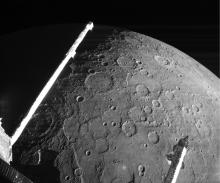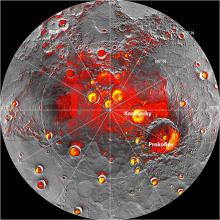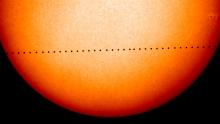Listen to today's episode of StarDate on the web the same day it airs in high-quality streaming audio without any extra ads or announcements. Choose a $8 one-month pass, or listen every day for a year for just $30.
You are here
Evening Mercury
Every mission to the planets creates as many new questions as it answers.
An example is Messenger, the only spacecraft to orbit the planet Mercury. It mapped smooth volcanic plains that are billions of years old. And it found smaller smooth patches that may be more recent — perhaps the result of eruptions as recently as a billion years ago. Yet Messenger’s pictures weren’t quite clear enough to confirm their origin. So geologists can’t work out the details of Mercury’s volcanic history.
The large plains cover about a quarter of Mercury’s surface. They formed as molten rock bubbled up through the crust — a process that ended three-and-a-half billion years ago.
Many of the smaller volcanic regions are much younger. They appear to be related to volcanic vents — indentations in the ground that may have produced explosive eruptions. And channels in the smaller plains could have been carved by flowing lava.
Scientists might get confirmation of that scenario in a few years. A European mission will enter orbit around Mercury in 2026. It will provide sharper views of the surface, and better maps of its composition. That may help solve the mystery of Mercury’s volcanoes — while posing new questions for future missions to the Sun’s closest planet.
Mercury is in the early evening sky now. It looks like a bright star quite low in the west-northwest as night falls, well above brighter Venus. It’ll remain in view for most of the month.
Script by Damond Benningfield






